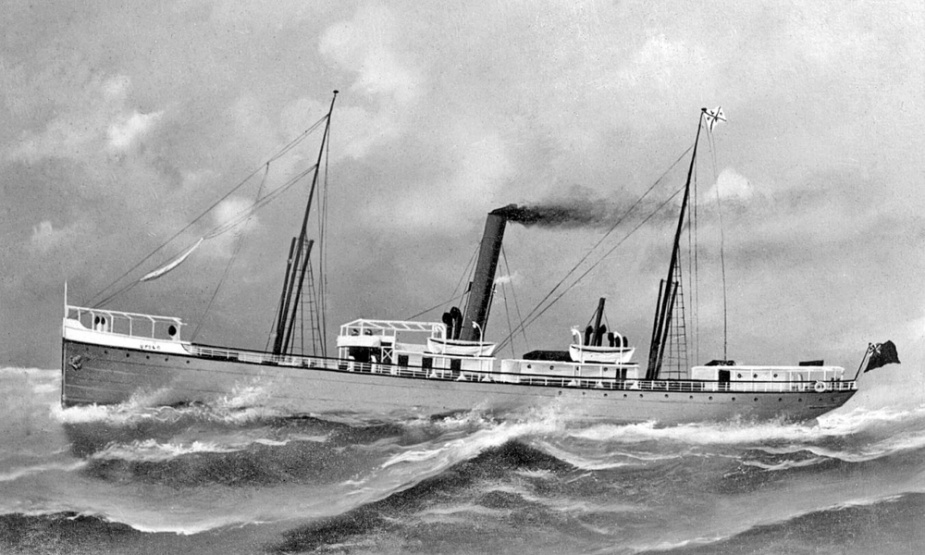
HMAS Upolu (Image courtesy of Jack Coyle).
The ship was chartered by the RAN on 18 August 1914 from its owners at a cost of £500 per month. It was converted into a submarine depot ship to support the 2 submarines, HMA Submarines AE1 and AE2, for operations in German New Guinea waters. Upolu was unarmed but additional workshop equipment, machinery and a motorboat was embarked for its naval service. Its master, Thomas Moore, was commissioned as a Lieutenant in the RAN Reserve, and most of its civilian officers and crew were enlisted in the RAN. A RAN paymaster officer, a surgeon and a warrant officer telegraphist were also appointed to the ship which ultimately had a crew of 45. Spare submarine crew members and engineering staff also joined the ship for the voyage north.
Upolu would prove to be an unsuitable choice as depot ship as it was only able to steam at 10 knots (the best its old coal fired boilers could manage) and it was mechanically unreliable. When the submarines were ready to sail north, in company with HMAS Protector as armed escort, they were initially delayed due to engineering problems with Upolu. The 2 submarines and their support vessels sailed from Sydney in late August 1914 and arrived at Palm Island, near Townsville, in early September.
Upolu, Protector and the 2 submarines left Palm Island on 4 September 1914 with orders to rendezvous with the rest of the fleet east of the Louisiade Archipelago on 9 September in preparation for the operation to seize German New Guinea. A defect in Upolu’s condensers reduced its speed to 6 knots so it and Protector were ordered to sail directly to Rabaul, but even at their best speed they would not reach there until after the main fleet had arrived. Both vessels reached Rabaul late on 11 September and anchored overnight. The fighting ashore had concluded on the evening of the 11th but the location of Vice Admiral Maximilain Graf von Spee’s German East Asian Squadron was still not known, and the surrender of German New Guinea was not concluded until the 17th.
AE1 was on patrol off the Duke of York Island group when it disappeared on 14 September 1914. It was last seen by the crew of HMAS Parramatta on the afternoon of the 14th but failed to return to the fleet anchorage at Rabaul that evening. A major search began that night and continued into the next day but no trace of the missing vessel was found. Upolu and AE2 remained at Rabaul until the beginning of October. It was not until December 2017 that the wreck of AE1 was discovered. It appears it had conducted a test dive while returning to Rabaul and an incident occurred which caused the submarine to sink in over 300 metres of water with the loss of the entire crew of 35 men.
On 3 October 1914 Vice Admiral George Patey, the Flag Officer Commanding His Majesty’s Australian Fleet, was directed by the Admiralty to take his forces to Suva, Fiji and make this his main base in the hunt for the German East Asian Squadron. HMA Ships Australia, Sydney and the French cruiser Montcalm sailed that day with HMA Ships Encounter, Parramatta and Warrego, HMAS AE2, and the fleet auxiliaries Aorangi and Esturia departing the following day. Upolu and the hospital ship Grantala, due to their slower speed, sailed independently with Upolu again struggling to reach port due to mechanical problems. Australia and its consorts arrived at Suva on the 12th and by the 15th there were 18 warships and auxiliaries in the harbour.
Training commenced for operations against von Spee’s cruisers but their location was still unknown. Parramatta ran aground on a sandbank in Suva harbour on 22 October but extracted herself under its own steam. It went alongside Upolu the next morning where divers examined the destroyer’s hull, but it was, fortunately, not damaged. On 7 November Australia was finally directed to proceed eastwards to the North American west coast in search of the German squadron. The rest of the fleet had already begun heading back to Sydney in dribs and drabs prior to this. AE2 sailed from Suva on 8 November, in company with Parramatta and Warrego, and after a brief stop in Noumea on 11 and 12 November, arrived in Sydney on the 16th and went straight to Cockatoo Island for maintenance.
Upolu sailed from Suva independently and arrived in Sydney in early November 1914 and its crew was demobilised on the 20th. It was returned to its owners on 9 December 1914. Upolu was sold to Arthur Bulkely Iffland van Ess, of Hong Kong, in 1915 and then on-sold to George McBain, Hong Kong, in 1916. The Shaw Hsing Steam Company of China purchased Upolu in 1921 and re-named its Tung An. While transporting coal from Tsingtao to Newchwang (now Yingkou) it sank following a collision with the SS Lien Hsing off the Shantung Promontory on 12 August 1930.
